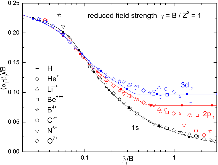Accurate and balanced anisotropic Gaussian type orbital basis sets for atoms in strong magnetic fields
- Hangzhou Normal Univ. (China)
- Univ. of Florida, Gainesville, FL (United States)
In high magnetic field calculations, anisotropic Gaussian type orbital (AGTO) basis functions are capable of reconciling the competing demands of the spherically symmetric Coulombic interaction and cylindrical magnetic (B field) confinement. However, the best available a priori procedure for composing highly accurate AGTO sets for atoms in a strong B field [W. Zhu et al., Phys. Rev. A 90, 022504 (2014)] yields very large basis sets. Their size is problematical for use in any calculation with unfavorable computational cost scaling. Here we provide an alternative constructive procedure. It is based upon analysis of the underlying physics of atoms in B fields that allow identification of several principles for the construction of AGTO basis sets. Aided by numerical optimization and parameter fitting, followed by fine tuning of fitting parameters, we devise formulae for generating accurate AGTO basis sets in an arbitrary B field. For the hydrogen iso-electronic sequence, a set depends on B field strength, nuclear charge, and orbital quantum numbers. For multi-electron systems, the basis set formulae also include adjustment to account for orbital occupations. Tests of the new basis sets for atoms H through C (1 ≤ Z ≤ 6) and ions Li+, Be+, and B+, in a wide B field range (0 ≤ B ≤ 2000 a.u.), show an accuracy better than a few μhartree for single-electron systems and a few hundredths to a few mHs for multi-electron atoms. The relative errors are similar for different atoms and ions in a large B field range, from a few to a couple of tens of millionths, thereby confirming rather uniform accuracy across the nuclear charge Z and B field strength values. Residual basis set errors are two to three orders of magnitude smaller than the electronic correlation energies in multi-electron atoms, a signal of the usefulness of the new AGTO basis sets in correlated wavefunction or density functional calculations for atomic and molecular systems in an external strong B field
- Research Organization:
- Univ. of Florida, Gainesville, FL (United States)
- Sponsoring Organization:
- USDOE
- Grant/Contract Number:
- SC0002139; SC- 0002139
- OSTI ID:
- 1512938
- Alternate ID(s):
- OSTI ID: 1414872
- Journal Information:
- Journal of Chemical Physics, Vol. 147, Issue 24; ISSN 0021-9606
- Publisher:
- American Institute of Physics (AIP)Copyright Statement
- Country of Publication:
- United States
- Language:
- English
Web of Science
Kohn–Sham energy decomposition for molecules in a magnetic field
|
journal | May 2018 |
Fully numerical electronic structure calculations on diatomic molecules in weak to strong magnetic fields
|
journal | March 2019 |
Similar Records
The transition from the open minimum to the ring minimum on the ground state and on the lowest excited state of like symmetry in ozone: A configuration interaction study
The transition from the open minimum to the ring minimum on the ground state and on the lowest excited state of like symmetry in ozone: A configuration interaction study







